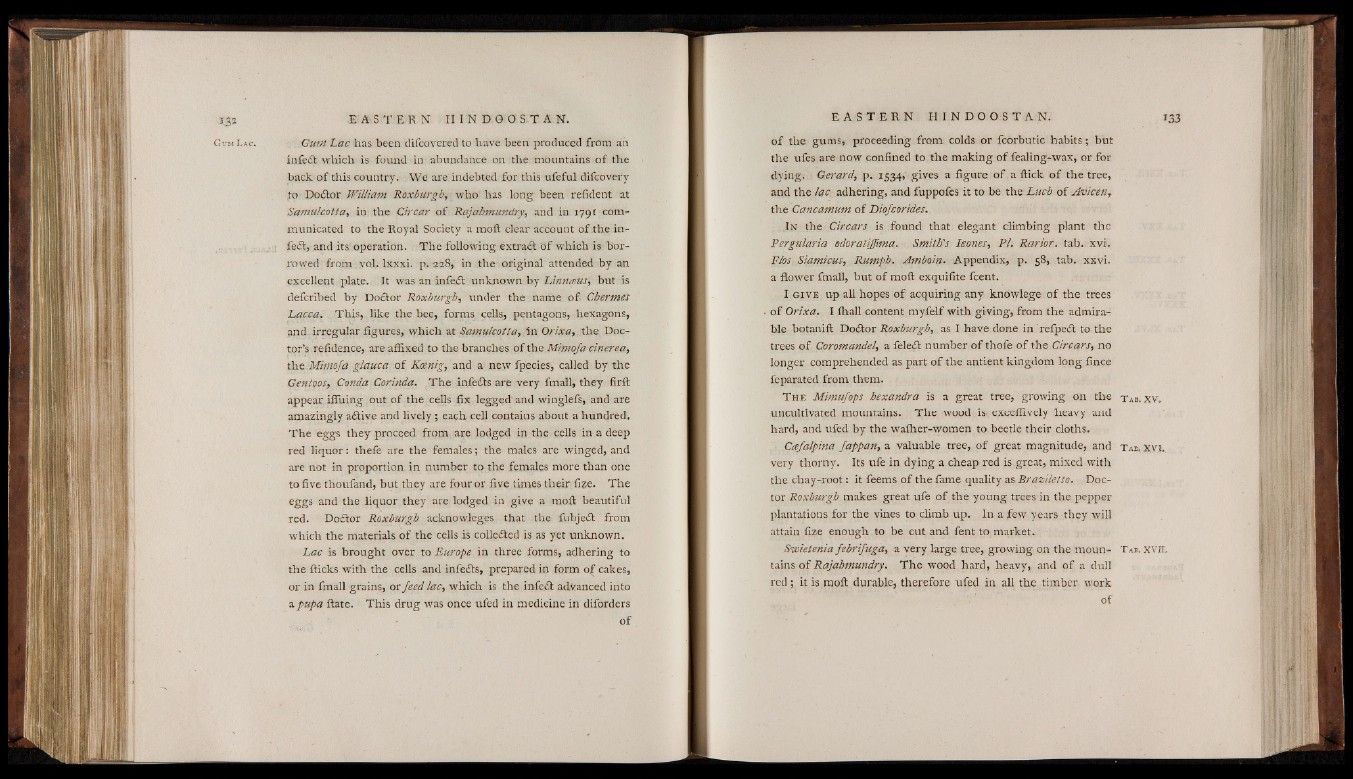
G um L a c . Gum Lac has been difcovered to have been produced from an
infeCt which is found in abundance on the mountains of the
back of this country. We are indebted for this ufeful difcovery
to DoCtor William Roxburgh, who has long been refident at
Samulcotta, in the Circar o f Rajahmundry, and in 179 c communicated
to the Royal Society a moft clear account of the infeCt,
and its: operation. The following extract of which is borrowed
from vol. lxxxi. p. 228, in the original attended by an
excellent plate. It was an infeCt unknown by Linneeus, but is
defcribed by DoCtor Roxburgh, under the name of. Cbermes
Lacca. This, like the bee, forms cells, pentagons, hexagons,
and irregular figures, which at Samulcotta, ftj Orixa, the Doctor’s
refidence, are affixed to the branches of the Mimofa cinerea,
the Mimofa glauca of Koenig, and a new fpecies, called by the
Gentoos, Conda Corinda. The infeCts are very fmall, they firft
appear iffuing out of the cells fix legged and winglefs, and are
amazingly aCtive and lively ; each cell contains about a hundred.
The eggs they proceed from are lodged in the cells in a deep
red liquor: thefe are the females; the males are winged, and
are not in proportion in number to the females more than one
to five thoufand, but they are four or five times their fize. The
eggs and the liquor they are lodged in give a moft beautiful
red. DoCtor Roxburgh ack-nowleges that the fubjeCt from
which the materials o f the cells is collected is as yet unknown.
Lac is brought over to Europe in three forms, adhering to
the flicks with the cells and infeCts, prepared in form of cakes,
or in fmall grains, or feed lac, which is the infeCt advanced into
a pupa ftate. This drug was once ufed in medicine in diforders
of
of the gums, proceeding from colds or fcorbutic habits; but
the ufes are now confined to the making of fealing-wax, or for
dying. Gerard, p. 1534, gives a figure o f a ftick of the tree,
and the lac adhering, and fuppofes it to be the Lucb of Avicen,
the Cancamum of Diofcorides.
I n the Circars is found that elegant climbing plant the
Pergularia odoratiffima. Smith's leones, PI. Rarior. tab. x v i.
Flos, Siamicus, Rumph. Amboin. Appendix, p. 58, tab. xxvi.
a flower fmall, but of moft exquifite fcent.
I g i v e up all hopes of acquiring any knowlege of the trees
o f Orixa. I fhall content myfelf with giving, from the admirable
botanift DoCtor Roxburgh, as I have done in refpeCt to the
trees o f Coromandel, a feleCt number o f thofe of the Circars, no
longer comprehended as part of the antient kingdom long fince
feparated from them.
T he Mimufops bexandra is a great tree, growing on th e tab. x v .
uncultivated mountains. T h e wood is. exce fiively h e a v y and
hard, and ufed b y the wafher-women to beetle th eir cloths.
Cafalpind fappan, a valuable tree, of great magnitude, and t a b . XVI.
very thorny. Its ufe in dying a cheap red is great, mixed with
the chay-root: it feems of the fame quality as Braziletto. Doctor
Roxburgh makes great ufe of the young trees in the pepper
plantations for the vines to climb up. In a few years they will
attain fize enough to be cut and fent to market.
Swietenia febrifuga, a very large tree, growing on the moun- T ab. xvn,
tains o f Rajahmundry. The wood hard, heavy, and of a dull
red; it is moft durable, therefore ufed in all the timber work
of